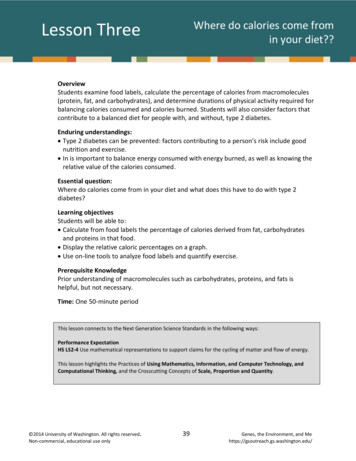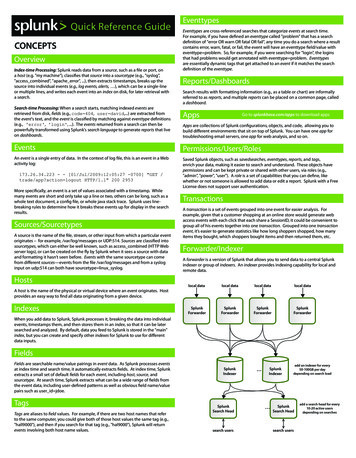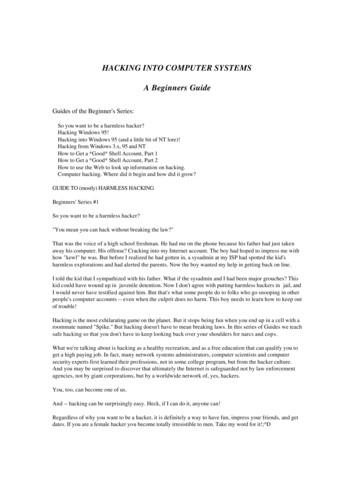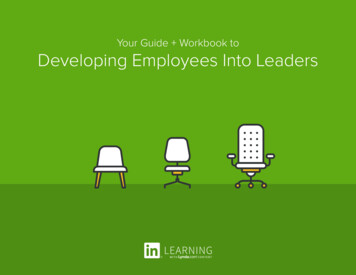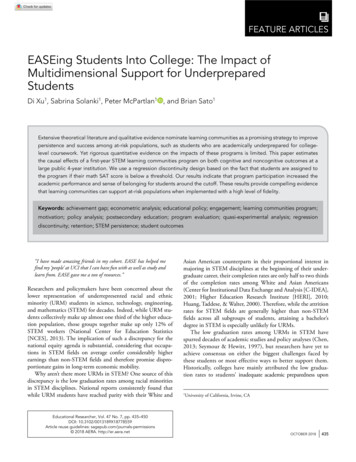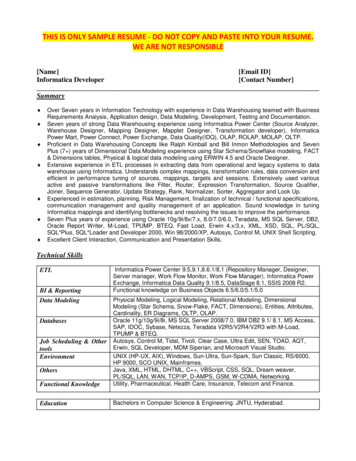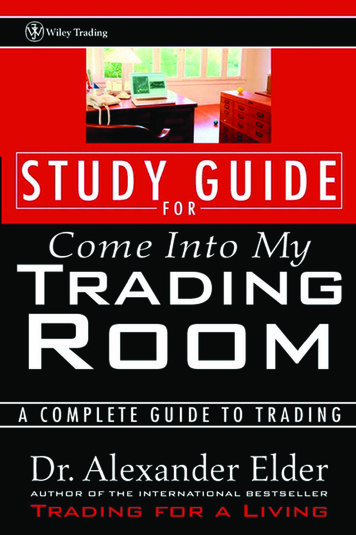
Transcription
STUDY GUIDEFORCOME INTO MY TRADING ROOMDr. Alexander Elderwww.elder.comJohn Wiley & Sons, Inc.New York Chichester Weinheim Brisbane Singapore Toronto
STUDY GUIDEFORCOME INTO MY TRADING ROOM
BOOKSBYDR. ALEXANDER ELDERTrading for a LivingStudy Guide for Trading for a LivingRubles to Dollars:Making Money on Russia’s Exploding Financial Frontier
STUDY GUIDEFORCOME INTO MY TRADING ROOMDr. Alexander Elderwww.elder.comJohn Wiley & Sons, Inc.New York Chichester Weinheim Brisbane Singapore Toronto
Copyright 2002 by Dr. Alexander Elder. All rights reserved.Published by John Wiley & Sons, Inc.No part of this publication may be reproduced, stored in a retrieval system or transmitted in any form or by any means, electronic, mechanical, photocopying, recording,scanning or otherwise, except as permitted under Sections 107 or 108 of the 1976United States Copyright Act, without either the prior written permission of thePublisher, or authorization through payment of the appropriate per-copy fee to theCopyright Clearance Center, 222 Rosewood Drive, Danvers, MA 01923, (978) 750-8400,fax (978) 750-4744. Requests to the Publisher for permission should be addressed tothe Permissions Department, John Wiley & Sons, Inc., 605 Third Avenue, New York,NY 10158-0012, (212) 850-6011, fax (212) 850-6008, E-Mail: PERMREQ@WILEY.COM.This publication is designed to provide accurate and authoritative information in regardto the subject matter covered. It is sold with the understanding that the publisher is notengaged in rendering professional services. If professional advice or other expert assistance is required, the services of a competent professional person should be sought.This title is also available in print as ISBN 0-471-22540-1. Some content that appears inthe print version of this book may not be available in this electronic edition.For more information about Wiley products, visit our web site at www.Wiley.com.
CONTENTSStudy Guide for Come Into My Trading Room1How This Book is Organized3Part One5Questions1Financial Trading for Babes in the WoodsQuestions 1–872Mind—The Disciplined TraderQuestions 9–18133Basic ChartingQuestions 19–23214Indicators—Five Bullets to a ClipQuestions 24–39275TradingQuestions 40–47396Day-TradingQuestions 48–53477Advanced ConceptsQuestions 54–67538Money ManagementQuestions 68–82639The Organized TraderQuestions 83–10071v
viCONTENTSPart TwoAnswers and Rating Scales831Financial Trading for Babes in the WoodsAnswers 1–8852Mind—The Disciplined TraderAnswers 9–18913Basic ChartingAnswers 19–23974Indicators—Five Bullets to a ClipAnswers 24–391015TradingAnswers 40–471116Day-TradingAnswers 48–531157Advanced ConceptsAnswers 54–671198Money ManagementAnswers 68–821279The Organized TraderAnswers 83–100133Part ThreeLet’s Trade: Case Studies and Questions141Part FourLet’s Trade: Answers and Ratings163The Road Ahead197Sources199About the Author201
STUDY GUIDE FORCOME INTOMY TRADING ROOMThink of the millions of people who throw money at stocks, options,and futures. Probably less than one percent of them ever pick up atrading book. Only a tiny fraction of those perform any learning exercises or take tests. If you can work through this Study Guide, grade yourperformance, then study and retake some of the tests if necessary, youwill belong to a small sophisticated minority.It is easy to sit at a lecture, sagely nod your head, and think youunderstand everything. What if someone asks you a question about thatlecture a week or a month later? Will you be able to answer, or will youhave forgotten by then?It took me three years to write Come into My Trading Room, yet aperson can read it in just a few days. Do you expect to get full value outof it after a quick read? Or will you return, reread, review, and underline key sections and paragraphs? I created this Study Guide to helpyou grasp the main ideas in my book, expose blind spots, and achievea deeper degree of understanding.Do not rush yourself through this workbook. Take the tests one chapter at a time and keep returning to the original source until you get thatchapter right. Then move to the next one. There is nothing wrong withtaking several weeks to work through this book. Quality is more important than speed.1
HOW THIS BOOKIS ORGANIZEDThe first section, Financial Trading for Babes in the Woods, quizzes youon the essential basics of trading. It asks about the efficient market theory, account size, and external barriers to winning, as well as marketdata and types of analysis. Rate your answers on the scales that are provided in each chapter. If you get a high grade, move on to the nextchapter, but if your score is low, return to the main book and workthrough the basics before going any further.Once you have covered the basics, it is time to move on to the threeM’s of successful trading, starting with the first—Mind. Questions in thesecond chapter deal with trading psychology, causes of losing, tradingattitude, and, of course, discipline. Rate your answers on the scale. Ifyour score is high, move on; otherwise, return to the main book. Manybrilliant people fail in trading; no technical tools can help those whoseminds are not in gear with the markets.The second M—Method—is covered in several chapters. First, thechapter on basic charting quizzes you on classical technical analysis.The next chapter, on indicators, delves into moving averages, channels,MACD, Force Index, Elder-ray, and Stochastic. The next chapter, on trading, asks questions about system testing, timeframes, and Triple Screen.Feel free to skip the chapter on day-trading if you do not day-trade.Finally, there is a chapter that asks about new, revolutionary methodspresented in the main book—the Impulse System and SafeZone stops.Money management is the key skill that separates winners from losers. This chapter quizzes you about the 2% and the 6% Rules, mathematical expectation and position sizing. Make sure you answer eachquestion right, and if not, return to the main book. Nothing less than aperfect score is acceptable in this chapter!3
4HOW THIS BOOK IS ORGANIZEDWe conclude the Study Guide with a chapter called The OrganizedTrader. A person who is serious about his success has to organize hisdecision-making process and record-keeping. Questions in this chapterdeal with trading records such as the equity curve, trading spreadsheet,and trader’s diary. They cover time management, setting priorities, andrating your performance.The charts in the Study Guide go beyond illustrating key analyticpoints. Each comes with questions about what you would do at the rightedge. Signals tend to be clearly visible in the middle of the chart, butgrow foggy as you get closer to the hard right edge. That’s where youhave to make trading decisions, in the atmosphere of uncertainty. ThisStudy Guide is designed to train you to decide at that crucial barrierwhere people make or lose money.Take your time as you go through the questions and exercises. Somequestions may be hard, but hang on and work through them. A boot campmay feel overwhelming to a soldier, but it is designed to toughen him, sothat he may survive the battle and come back alive and victorious.
P A R TO N EQUESTIONS
O N EFINANCIAL TRADING FORBABES IN THE WOODSTrading is serious business, no less so than building a house or teaching calculus. Being smart and having good ideas is not enough for winning. You must understand the mechanics of the markets and theessential principles of analysis and risk control.You need to learn the key facts and rules before entering your firsttrade. The first chapter of the Study Guide tests your knowledge of someof those concepts. Answer these eight questions and write down youranswers. Go to the Answers section, check your responses, and thenenter your grade for each answer in the first column of the spreadsheet.There are five columns to enable you to return at a later date, retake thetest, compare your results, and measure your progress.7
8QUESTIONSQuestionsTrial 1Trial 2Trial 3Trial 4Trial 512345678Total pointsQuestion 1—Decision MakingMatch the statements on the decision-making process with the typeof trader.1. A person hears a tip at a party and buys that stock in the morning.2. A person hears a tip at a party and spends the next morning researching that stock and the industry group.3. A person hears several people gossiping about a stock at a party andpulls it up on his computer with a view to selling it short.4. A person sees a TV show about a famous investor and buys thestocks that he mentions.5. A person reads a news release regarding disappointing earningsfrom a high-tech company and pulls up its chart the next day to seehow it reacts to the report.6. A person buys a stock after receiving a call from a relative workingfor a penny stock company who tells him of that firm’s technological breakthrough that has not yet been disclosed to the public.
FINANCIAL TRADING FOR BABES IN THE WOODS9A. InvestorB. TraderC. GamblerQuestion 2—Efficient Market TheoryWhich of the following statements regarding the efficient market theoryare true and which are false?1. All traders focus on maximizing profits and minimizing losses.2. The outcome of any single trade is largely a matter of luck.3. A trader whose account has increased after a year of active tradingis very lucky.4. Trading in a room with a group of people leads to more objectivedecisions.5. Markets become more efficient when they become less volatile.Question 3—Trading ChoicesMatch the following statements with the trading terms:1. Finding these points is the hardest aspect of trading.2. Buy when a rally accelerates, and sell when it starts losing speed.3. These must be planned in advance; do not chase the markets.4. This is the most often ignored aspect of trading.5. Buy when a downside breakout starts pulling back up into the range,and liquidate within the range.A. Countertrend tradingB. EntriesC. Money managementD. Momentum tradingE. Exits
10QUESTIONSQuestion 4—Stocks, Options, and FuturesMatch the following statements with one or more of the trading vehicles.1. The buyer must be right on the vehicle, price, and time.2. This is a certificate of business ownership.3. Money management skills are essential for success.4. This is a contract for future delivery.5. It’s OK to buy cheap, but not OK to buy down.A. StocksB. FuturesC. OptionsQuestion 5—Barriers to WinningMatch each statement with one or more of the external barriers towinning.1. They impact your account more than market trends.2. They must be monitored so as not to exceed a small percentage ofyour account.3. This is the distance between the price at which you place a marketorder and at which it is executed.4. This is a meaningless percentage of your account.5. This is an inevitable cost of entering markets.A. CommissionsB. SlippageC. ExpensesD. None
FINANCIAL TRADING FOR BABES IN THE WOODS11Question 6—Account SizeFive traders with similar levels of skill and all using stops enter the stockmarket. Which is likely to generate the highest percentage return?1. 50,000 account; 5,000 maximum stop on any trade2. 15,000 account; 1,500 maximum stop on any trade3. 250,000 account; 50,000 maximum stop on any trade4. 50,000 account; 1,000 maximum stop on any trade5. 250,000 account; 5,000 maximum stop on any tradeQuestion 7—Market DataWhich of the following statements are true?1. Real-time data is essential for timing entries and exits.2. The more markets you follow, the more money you will make trading.3. You must keep abreast of earnings reports for the stocks you follow.4. Futures can sell for less than the cost of production.5. Having 12 months’ worth of daily charts makes weekly charts unnecessary.6. Good software makes up for traders’ inexperience.A. 1 and 2B. 2 and 3C. 3 and 4D. 4 and 5E. 5 and 6
12Question 8—Types of AnalysisMatch each phrase with the types of analysis.1. Studies economic supply and demand2. Forecasts future prices3. Studies crowd behavior4. Can be fully automated5. Serves as a basis of trading decisionsA. Fundamental analysisB. Technical analysisC. BothD. NeitherQUESTIONS
T W OMIND—THE DISCIPLINED TRADERYour personality is the key component of your trading success. Yourthoughts, feelings, and attitudes have an immediate and direct impact onwhat happens to your account and whether it rises or falls. No level ofcomputer power and no amount of technical expertise will do a traderany good if his mind is unsettled.One day, if you get the chance, rent Solaris, a film by the late, greatdirector Andrei Tarkovski. In this sci-fi film, a planet that has beenbombarded by the scientists responds by reaching into their minds,extracting their most painful memories, and recreating those experiences for them. They must come to terms with those memories andresolve their old conflicts before becoming capable of getting in touchwith the planet. Markets act like that planet in the sense that theyreach deep into our minds, find our weaknesses, and hit us in ourweak spots.Greed, fear, carelessness, sloth, and other sins of omission or commission make successful trading difficult or impossible for most people. You have to look into the mirror, record your actions, recognizewhat you are doing wrong, and then correct your attitudes. Becominga successful trader means becoming a more balanced and maturehuman being.13
14QUESTIONSQuestionsTrial 1Trial 2Trial 3Trial 4Trial 59101112131415161718Total pointsQuestion 9—Why Trade?People trade for many reasons, some rational and some irrational. Findtwo that make logical sense.1. You need a challenge and adventure.2. You want to make more money than is available from risklessinvestments.3. You feel fed up with your day job.4. You are more intelligent than most people you meet.5. You want to make money.A. 1 and 3B. 4 and 5C. 2 and 5D. 2 and 3
MIND—THE DISCIPLINED TRADER15Question 10—Trading PsychologyMatch e
Study Guide for Come Into My Trading Room 1 How This Book is Organized 3 Part One Questions 5 1 Financial Trading for Babes in the Woods 7 Questions 1–8 2 Mind—The Disciplined Trader 13 Questions 9–18 3 Basic Charting 21 Questions 19–23 4 Indicators—Five Bullets to a Clip 27 Questions 24–39 5 Trading 39 Questions 40–47 6 Day-Trading 47 Questions 48–53 7 Advanced Concepts 53 .




